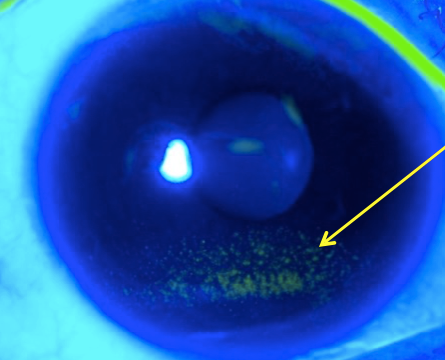Send a text to (757) 355-5553 to make an appointment or learn more!
Dry Eye Syndrome and Blepharitis
Dry Eye Syndrome and Blepharitis are two of the fastest growing eye conditions in America. They are seen in patients of all ages, and there is a plethora of ways to treat them. At Sea Eye Care, Dr. James Komornik utilizes all of these treatment avenues.
Dry Eye Syndrome is a condition where different factors separately or together result in the eyes’ producing a poor quality tear film that does an inadequate job of lubricating the eyes. Those factors include bad quality oil secretion, clogged oil glands, insufficient tear secretion, irregular tear drainage, incomplete eyelid closure, some medications, some general health diseases, contact lens use, and many others.
- Symptoms of Dry Eye Syndrome include burning, irritation, itchiness, fluctuating vision, feeling like there is grit in the eyes, and many other sensations.
- Signs of the condition can be seen by a high tear osmolarity number (a quantitative dryness test), a quick tear break-up time (how long it takes your tears to evaporate), a reduced tear prism (small amount of tears on the eye when visualized with the slit-lamp microscope), a positive Matrix Metalloproteinase 9 marker (an inflammation screening test), and more.
- Treatment options include over-the-counter lubricating drops, warm compresses, lifestyle changes, prescription drops, oral over-the-counter and prescription medications, and in-office procedures. Dr. Komornik evaluates your signs and symptoms and determines the best treatment option individualized to each patient.
The staff at Sea Eye Care work closely with pharmaceutical company representatives to stay updated on all new discount plans and promotions. Often, our staff can do the online forms and applications for discounts on medications for you in office if you are not sure of how, and if you would like to do it yourself we can provide you with all the steps easily laid out.
At Sea Eye Care, we carry dry eye and blepharitis over-the-counter products to increase accessibility as well as extend our buying power’s discount to our patients. We offer products including Oasis lid scrubs with Tea Tree Oil, Dry Eye Relief Masks, Physician's Recommended Neutracuticals omega-3 dry eye pills, and Oasis Plus Artificial Tears. Outside of dry eye and blepharitis products, we also offer AREDS2 pills for patients who have macular degeneration.
For patients who have symptoms that are recalcitrant to lubricating drops, prescription drops, and other over-the-counter remedies, Dr. Komornik will provide in-office procedures to help symptoms.
For patients with dry eye syndrome, to keep the natural and instilled artificial tears on the eyes longer, plugs can be placed in the drainage system of the eyes. These plugs are made of collagen (what our bodies are made of) and last six months before dissolving naturally on their own. Patients find great relief with this treatment modality and find they become less dependable on lubricating drops afterwards. The plug placement service as well as the plug cost themselves often can be billed through patients’ medical insurance.
Patients with dry eye syndrome that is significant and not resolving with modest treatment may require amniotic membrane placement. Dry eye patients that also have blepharitis may require different routes of treatment as well. Blepharitis is inflammation along the eyelid margin that can cause the eyes to produce poor quality oils as well as flakey material that adheres around the eyelashes. This flakey material cannot be removed with traditional washing of the face, because it forms a biofilm along the eyelashes. Oasis Lid Scrubs with Tea Tree Oil can help, but some cases require a more progressive approach. These are the instances LidPro in-office eyelid cleanings may be required where a device goes across the eyelids and lashes and cleans off any debris from blepharitis.
Dr. Komornik looks at the full clinical picture and determines a treatment approach that is most appropriate for each individual patient, rather than using a cookie-cutter approach.

After fluorescein dye is applied to the eye and viewed under a cobalt blue filter: dry spots on the cornea are highlighted and visualized by eye care providers. These dry spots have many names, one including puntate epithelial erosions.
Dr. Komornik relates dry eye to dry skin. In the photo one can note crevices along the front surface of the eye (the cornea).
These crevices are highlighted by the dye that was placed in the eye prior to takin the picture.
The cracks/crevices are much like cracks in the ground in the dessert, or cracks/roughened up areas on dry skin.
During the exam, the degree of these dry spots, as well as other factors, play a key role in Dr. Komornik's decision making and to determine which treatment modality will help alleviate symptoms the best.
Findings may indicate the need for prescription drops like RESTASIS® or Xiidra®, the need for punctal plug placement, or other treatments.
These crevices are highlighted by the dye that was placed in the eye prior to takin the picture.
The cracks/crevices are much like cracks in the ground in the dessert, or cracks/roughened up areas on dry skin.
During the exam, the degree of these dry spots, as well as other factors, play a key role in Dr. Komornik's decision making and to determine which treatment modality will help alleviate symptoms the best.
Findings may indicate the need for prescription drops like RESTASIS® or Xiidra®, the need for punctal plug placement, or other treatments.

